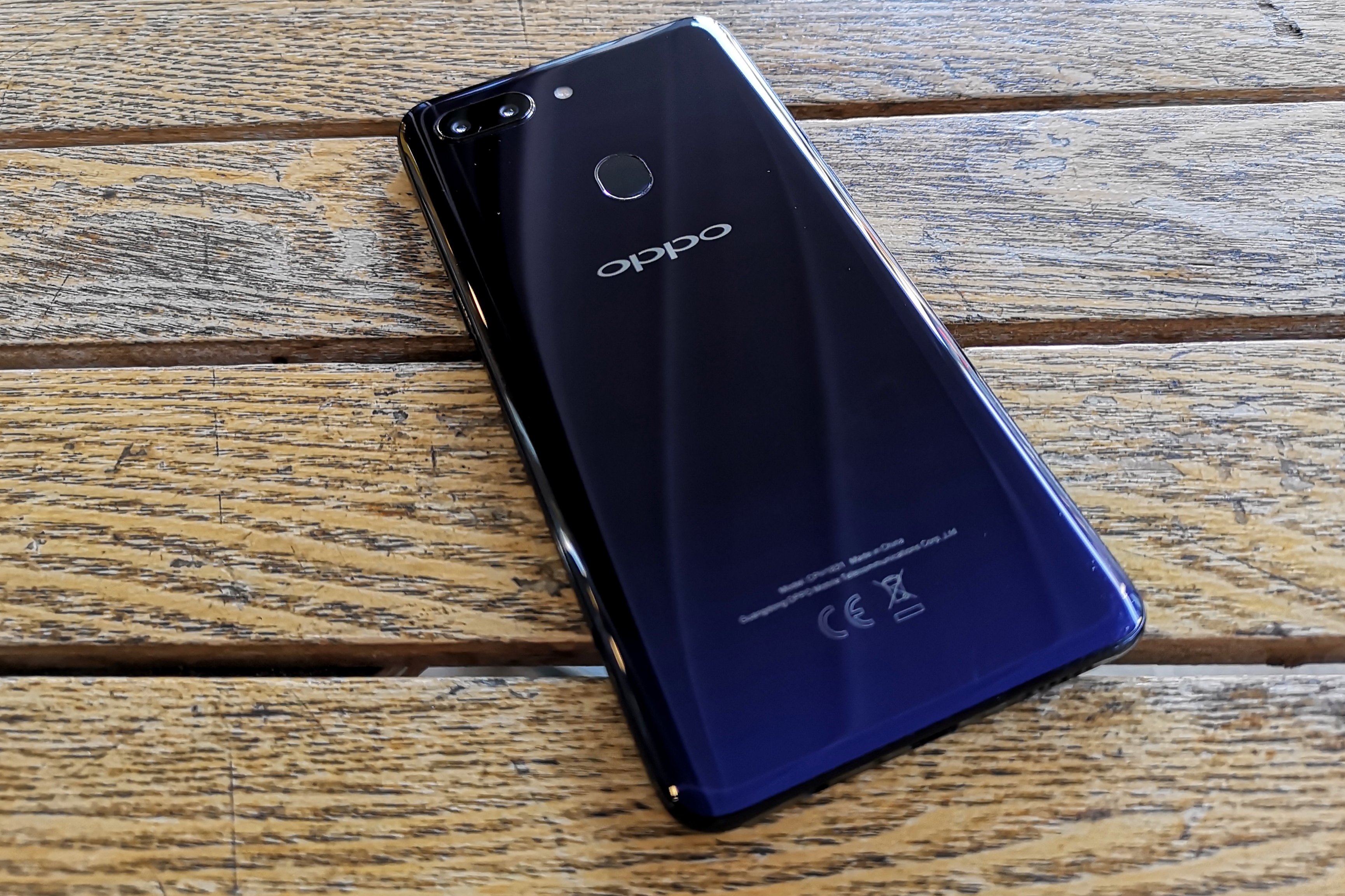
It’s past time for us to talk about Oppo’s R15 Pro. With its successor just announced, and the R15 Pro widely available across Australian carriers and MVNOs on both pre/post-paid plans, you’re sure to find it on offer if you’re out shopping for a phone.
The R15 Pro is big smartphone, but the biggest thing about it is perhaps its price. It’s a $780 smartphone, the highest price we’ve seen attached to an Oppo R Series phone, and one that merits a little closer investigation.
We’ve often leveled a bit of criticism at Oppo for lacking some features in their phones, and the R15 Pro goes some way to addressing this. The phone has an IP rating, there’s a standard fingerprint sensor placement and unexpectedly, it’s even got NFC on board.
In the box, you’ll find the R15 Pro with its big 6.3-inch full screen display, 3.5mm earphones, an Oppo VOOC rapid charger and USB cable, a SIM card ejector tool and a slim clear plastic case for the phone. That last part is always especially welcome – it’s great to be able to protect your phone as soon as you take it out of the box, and we won’t stop calling it out as a trend we’d like to see the industry adopt.
Hardware
The R15 Pro represents a graduation for Oppo, moving the R Series from its metal body construction to a more premium-grade materials build – a now-standard metal frame with glass front and back construction. It’s the first time we’ve seen such construction from Oppo, and it’s a welcome upgrade – the R15 Pro feels more like a premium phone in the hand with that new glass back. Of course, it’s a fingerprint and dust magnet – that’s par for the course though.
Oppo’s even nailed the placement of the fingerprint sensor – it’s dead centre on the upper half of the rear. Coupled with the use of on-screen buttons, the R15 Pro very much follows reference Android specs for its componentry and placement.
The rear glass finish on our review unit is “cosmic purple” – it’s mainly black, but has a playful purple gradient that shows up better in some light than other. There’s also a more overt “ruby red” finish on offer. We’ve seen Oppo experiment with colour over the last few years with some fantastic results, and it’s good to see this trend continue.
We’ve always loved Oppo’s hardware and the specs they cram into their devices, and the R15 Pro is no different. The R Series has always been powered by Snapdragon 6xx series processors in the past, and the Pro carries the top of that line – the Snapdragon 660. It’s paired up with an enormous 6GB of RAM that aids multitasking to no end, and there’s 128GB of storage on offer with Micro SD expansion.
On the charging front, there’s regrettably no wireless charging to go with that glass construction (maybe next year), and the charging port remains Micro USB. Oppo’s VOOC rapid charging is ever-present though, and is likely the reason Oppo’s comfortable bypassing a wireless option. The phone’s generous 3430 mAh battery also charges pretty quickly from a standard USB charger or battery.

If like me, you’ve been drawn into the world of mobile payments then this is the first Oppo phone that can support your tap-and-pay habit – the R15 Pro finally features NFC (a benefit of that new glass construction) and you can tap to your heart’s content. I set up Google Pay on the device with no issues whatsoever.
Finally, there’s a 3.5mm headphone jack. Considering Oppo was one of the first to produce a phone without one (the R5 was SO long ago!) it’s funny to see this feature still hanging around – I found it a very welcome addition when watching a lot of downloaded Netflix videos on a recent long haul flight.

The R15 Pro’s display clocks in with about the same resolution as the previous R11S model – it’s essentially FullHD+ with a few more pixels top and bottom to give it its 19:9 aspect ratio. Paired up with the Snapdragon 660, it means the phone sips its battery lightly.
It also features the must-have screen accessory of 2018 – a notch in its display. Here, the notch holds a proximity sensor, front-facing camera and phone speaker. It’s a fairly standard size, about the same as the Huawei P20 Pro. There’s also a slight chin on the lower edge of the screen which betrays the “full screen”, but also isn’t out of line with other phones.
Unlike other proponents of the notch though, Oppo doesn’t let you “disable” (read: hide) it with a software setting to force the status bar black, which means I had a chunk missing from my full screen video for most of that long-haul flight.

Camera
We’ve always been fond of Oppo’s pedigree in photography. It belies the “midrange phone” label applied to the company’s phones and helps them in the bang-for-buck territory, although some of the recent advancements at the high end of the market are seeing the gulf between premium and midrange widen.
The R15 Pro (and indeed the R15) feature on-device AI scene recognition. Point the camera at a subject and it’ll attempt to identify it and classify it. Dogs and cats are treated separately, and it’ll identify food, landscapes, sunrises and more. The camera can apparently recognise some 120 scenes, although I’m not really sure what it does once it’s identified them.
The results aren’t as pronounced as, say, Huawei’s Master AI feature – that’s probably a good thing, as users don’t really want to see their camera make such overt changes to saturation and colour temperature. In fact, I needed to take a second look to see how Oppo’s AI manifests as I didn’t see it at first.
The camera doesn’t seem to benefit as much from its dual camera array as you might expect – there’s no fancy refocusing-in-post effects on offer, although portrait mode does pull focus nicely onto your subject as long as you frame it well.
Oppo’s paid special attention to face recognition smarts in recent devices, and the R15 Pro is no exception. The camera software can identify a high number of points to which it can apply pattern matching, and this manifests in both Face Unlock and in the phone’s Beauty mode which now applies far more subtle changes to your face than the hideous creations of years past, although you’ll want to keep an eye on it as it can still go a bit overboard. You can also beauty mode effects in post.
You also get iPhone-X-style dynamic lighting options in Portrait mode though, which seems to be “a thing” in phone camera software this season.
While the big players work on low light capabilities, Oppo’s quietly toiled on their own low light photography and in general their phones perform well in the dark, but not as well as the more expensive premium options. The R15 Pro did pull some impressive low light shots, but also missed a number of pictures that should have been gimmes, especially where low light white balance is concerned.
The R15 Pro’s camera delivers a solid but not standout performance, with above average photos although the results can be pretty inconsistent. In broad daylight it’ll take a lovely photo but in the dark you can end up frustrated. That’s not surprising for mid-range phones though, and it’s generally a solid performer.

Color OS
Let’s try to address the elephant in the room from the outset: We’ve had our differences with Oppo in the past over the direction their version of Android – Color OS – has taken. Color OS seems to take Apple’s iOS as its inspiration, and we saw the R11S go further than we’d seen before on this front (and further than we liked) with notifications and quick settings that took rather a lot of inspiration in this regard.
In the R15 Pro, this seems to have been backed off. Quick Settings has returned to the top of the pull-down notification shade, and notifications look a little more “Android-y” than they did in the past.
Notifications are still a pain to manage, though. The OS still hides the icons of the apps that have produced notifications, so you’re going to have to pull down the notification shade to see if a new message has arrived. You also, bizarrely, still can’t swipe them away and need to swipe each notification left, then press a big “Delete” button. It means you’re more likely to clear all notifications (an action which requires less steps than deleting a single notification). It also means you can’t easily swipe a notification away if it gets in the way of you using another app.
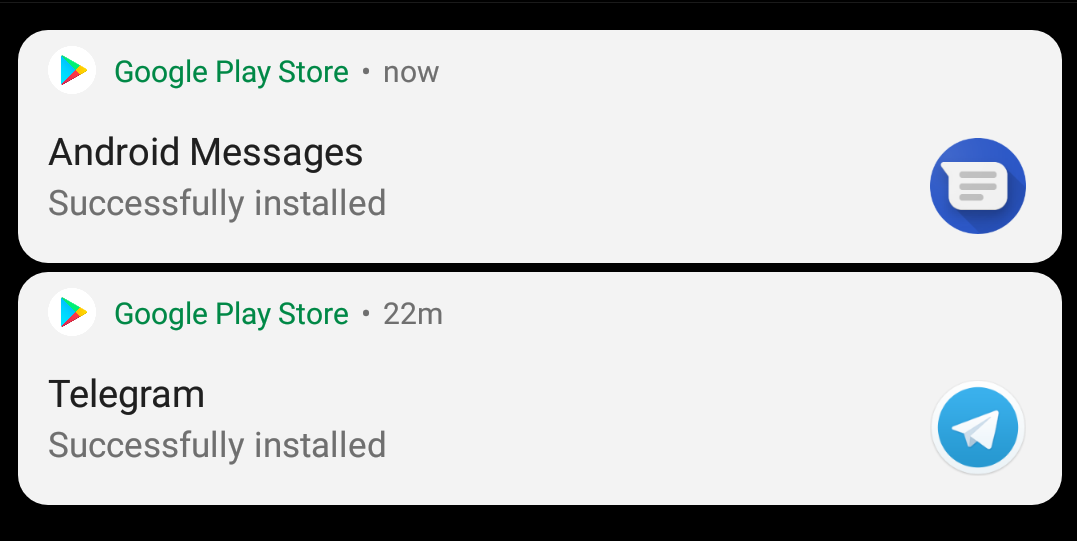
Notifications aside, the only thing I really felt it was necessary to do to the phone to make it mine was replace the launcher (now Nova) and the SMS app (I installed Android Messages). These are things that have tripped up previous R Series phones and the phone certainly gives you more than a few warnings that it would rather you didn’t change things), but Oppo’s taken that criticism on board and stopped restricting my choices. I would say “kudos” for this, but it’s something that should never have been a problem in the past.
Color OS also still betrays its non-English-speaking origins, with some clumsy phrasing and dialog layout.
There are a couple of interesting features that are worth discussing.
The first is the “Secure Keyboard” feature, which uses a different keyboard while in a password entry field. It’s a pretty good approximation of the standard Google keyboard (which also commendably ships as the R15 Pro’s default) and it also prevents you taking a screenshot while it’s active – which seems pretty reasonable. It also can’t be deactivated, which is more of a problem.
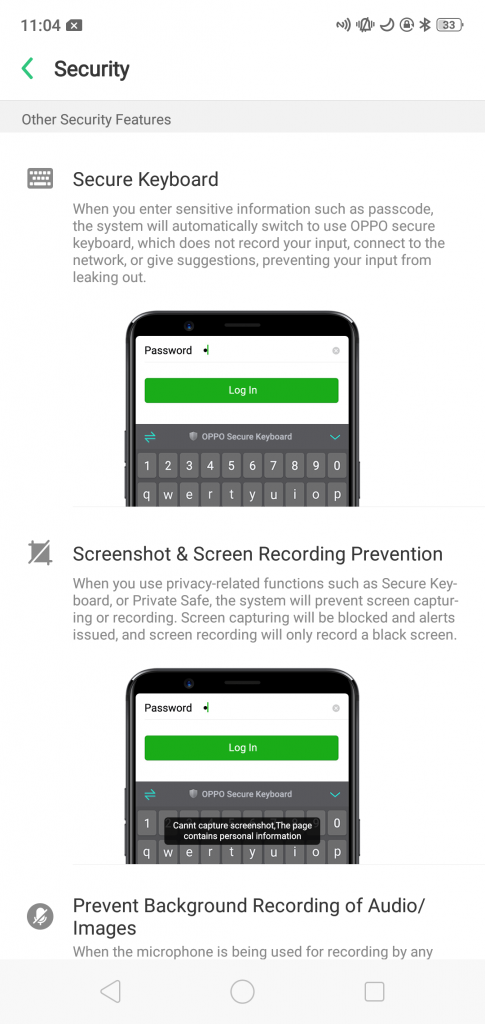
Another feature that’s aimed at personal security is on-screen warning that an application in the background has activated the microphone (the status bar changes colour). This is a feature request that’s been bubbling around the Android community for a while and it’s good to see Oppo get out there and implement some requested features.
There’s also an overt focus on defending the user from attacks, be they phishing or connection monitoring. Oppo’s phones are the only I’ve seen that offer protection to stop you connecting to fake base stations, for example, and specifically call out anti-harrassment whitelists/blacklists in security settings.
Finally, special mention must also go to Oppo’s Face Unlock feature, which activates when you raise the phone to look at it, and unlocks the phone so quickly you’re left with a nagging suspicion that you forgot to lock it in the first place. The phone doesn’t feature hardware aimed at foiling intentional fakery on this front though, so you should be a little cautious about relying on it.
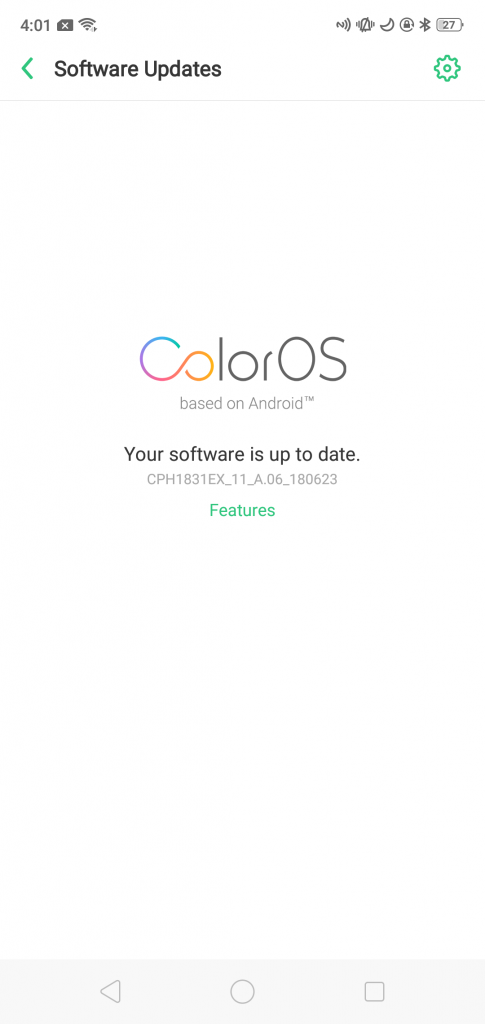
At odds with these features and their focus on personal security though is a longstanding problem – Oppo’s lack of software updates. The company has had a troubled history when it comes to this, and while our R15 Pro review unit is running the latest version of Android Oreo (8.1.0), it’s still stuck back in May on the security updates front (that’s prior to the phone’s release). It’s not clear when this will get updated, and Oppo seems unwilling to make a public commitment to doing so.
Color OS is undoubtedly Oppo’s achilles heel. We’d like to see an Australian device from the company running Android One.
So… should you get one?
Reviewing the R15 Pro is actually a little difficult without calling to mind the company’s past efforts. The phone is such a product of and an evolution over what’s gone before that it’s hard to call to mind a feature without comparing it to how that feature worked / didn’t work on the previous model.
I’ll put the familiar refrain here – it’s a mid-range powerhouse with a generous amount of ram and storage on offer. This has always been the case with Oppo hardware – the company finds a way to power up its devices with componentry a couple of generations ahead of its competitors. We’re seeing high GBs of RAM coming into the mainstream now at higher price points, and you’d be hard pressed to find most higher-priced phones offering 128GB of storage at their entry level.
Is the “mid-range” moniker really fair to apply to the R15 Pro, thought? This is a $780 phone, and it continues the R series’ ever-upward price point trend. By today’s standards, with other companies’ phones coming in at some $1500, yes it’s midrange-by-definition, but it’s the highest price we’ve seen attached to the R Series so you should probably take a more serious look at your options.
Motorola and Nokia for example are masters of the mid-range with phones at multiple price points below this. Those phones might be a cut under on specs, but you know you’ll get software updates. You may also find yourself going for a flagship of yesteryear where you’ll find perhaps higher spec hardware but the same update conundrum as most premium flagships seem to fall off the radar on updates in their second year.
It’s hard to understate this — on security alone, the lack of updates makes the R15 Pro a hard sell and we really don’t want to recommend it based on this.
If you decide you’re not bothered about updates though, then the R15 Pro is a well built and delivered phone. While we’ve taken issue with Color OS in the past, and continue to find some quirks with the way it implements some things, on this device it seems to deliver most of what we expect in an Android phone – its something you could learn to live with if you’re coming from a more standard Android platform. There’s great specs and a decent mid-range camera on offer, making it a typical – but pricey – Oppo smartphone.
















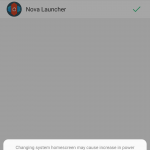






I have opportunity R15 pro can I access sms reminder, had it on Samsung,was great but can’t see how to access it.
Watch out for the Bluetooth not compatible in some cases and no solutions available and by the time you find out you have already bought the phone
I had an R9S and hated ColorOS so much I sold it. While Oppo still uses that OS, I will never touch one again. If Android One was available as an option, that would change my view.
I have bought this phone recently and I can happily say that I didn’t make any mistake to buy this phone. It’s nowhere less than iPhone. I used to be an iPhone user but not anymore due to there software problems and prices. Thanks Oppo 👊🏻👊🏻👊🏻
seems like a reasonable phone, however, the price is now creeping above what I could imagine most people would consider as reasonable for an outright purchase. I’d be tempted to look at a Galaxy S8, LG G6/7 or something from Nokia for similar or less coin.
I’ve had the Oppo R15 Pro for about 5 weeks now. Agree with most of your comments, the software does have a few quirks. I changed the launcher and SMS app as well but that’s about it. There wasn’t as much “bloatware” as I thought there would be which was a nice surprise. Software updates will be the big thing to watch. I did receive an update about two weeks ago that upgraded Color OS to 5.1 and the July security update (through Optus). Will be interesting to see how the updates go over the next 6-12 months. Overall, it’s… Read more »